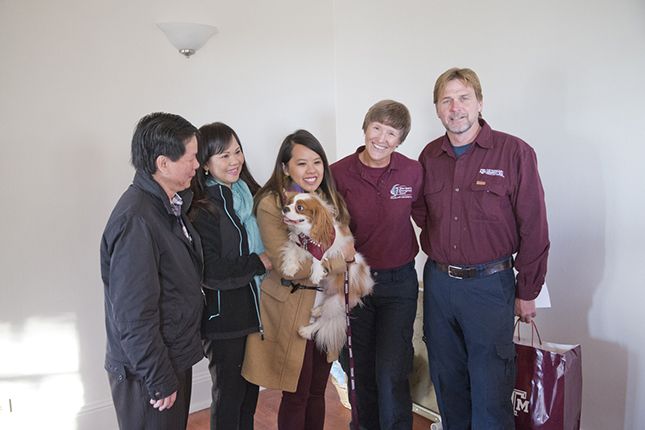After Texas A&M Veterinarians Assist In Monitoring Bentley, He Returns Home
COLLEGE STATION, Texas – After 21 days in quarantine for possible exposure to the Ebola virus, Bentley, the Cavalier King Charles Spaniel belonging to Texas nurse, Nina Pham, has returned home to his owner. Pham, who herself was successfully treated for Ebola after contracting the virus while caring for a patient in a Dallas area hospital, was grateful to bring Bentley home.

Very little is known about Ebola in dogs, so after Pham became ill, Bentley was placed in quarantine under the direction of Dallas Animal Services and Adoption Center. Two veterinarians from the Texas A&M University College of Veterinary Medicine & Biomedical Sciences (CVM) Veterinary Emergency Team
(VET) assisted in Bentley’s testing and care during his isolation period.
Dr. Wesley Bissett, director of the VET, and Dr. Deb Zoran, chief medical officer for the VET, worked cooperatively with multiple agencies to provide Bentley’s daily care and collect the needed blood, urine, and fecal samples from Bentley, which were shipped to a laboratory for testing for presence of the virus. To ensure Bentley was free from Ebola, two collections took place during the isolation period. All test results were negative for the presence of Ebola virus, so Bentley was able to be reunited with Pham.
“This has really been quite an extraordinary deployment,” said Bissett. “In all honesty, this is one that I would have never imagined. I know there are only two of us who are physically here, but the reality is that we are all here. We have all worked toward this very point where we are today. We are all standing behind Nina and Bentley.”
In addition to providing for his daily care, Bissett and Zoran also monitored Bentley’s psychological health by making sure he had toys to enrich his environment and was able to leave his crate to move around in his room.
The need for ensuring Bentley’s physical and psychological health in this unprecedented situation is an example of the VET’s commitment to the team’s mission of “Serving our state and nation every day.” This is accomplished by deploying the largest and most sophisticated veterinary medical disaster response team in the country, by developing and providing cutting edge emergency management education, by developing new knowledge in emergency preparedness education and response, and by building on the legacy of service that is at the heart of Texas A&M University.
“Our original focus was hurricanes, but our first deployments were a wildfire, then an explosion, a variety of search support missions, and now an Ebola outbreak,” said Zoran. “Although all of these have been different than what we originally thought we would be doing when we started all of this, we have navigated each challenge successfully.”
There were numerous influencers in the decision to care for Bentley. The risk to the public was felt to be minimal. While Bentley is the first Ebola exposed dog in the U.S., there have been no reports of dogs becoming ill from Ebola or of being implicated in the transmission to humans. Nonetheless, because of the nature of the virus, Bentley was managed with an abundance of caution. There was much to be learned from Bentley during his post exposure period. Would he shed the virus or not? Under tightly controlled isolation conditions, he was carefully monitored. Finally, the human animal bond is a powerful phenomenon. Assurance that Bentley was receiving excellent care would help Nina Pham by providing much needed encouragement for her own recovery. Because it is well-known that people will put themselves at risk in the interest of animals, people exposed to Ebola should be more likely to self-report early, if they are sure they are not putting their animals at risk by doing so.
For Bissett and Zoran, the other VET members, and the rest of the CVM family providing moral support from back home, Bentley holds a special place in their hearts. While the CVM eagerly waited for Bissett and Zoran to return, the concern everyone felt for this special dog and his owner, and the willingness to accept this mission, became a living example of the selfless service for which Texas A&M Aggies are known.
“We owe enormous thanks to Dr. Bissett and Dr. Zoran for their willingness to leave their families and their community to provide this much needed service in the State of Texas,” said Dr. Eleanor M. Green, the Carl B. King Dean of Veterinary Medicine. “We also thank Dr. Tammy Beckham, who took the first shift until Drs. Bissett and Zoran arrived. It is also important to point out the extensive expertise that was amassed behind the scenes to make the right decisions and assemble the right team expediently. Some of those included the Centers for Disease Control and Prevention (CDC), the Texas Department of State Health Services (DSHS), Texas Animal Health Commission (TAHC), American Veterinary Medical Association (AVMA), Dallas Animal Services, the City of Dallas, and the Texas A&M University College of Veterinary Medicine & Biomedical Sciences and its VET.”


